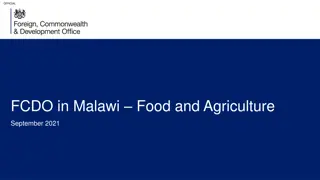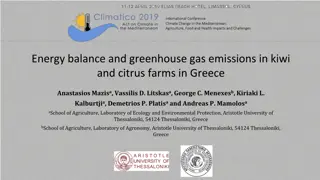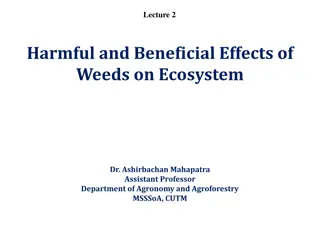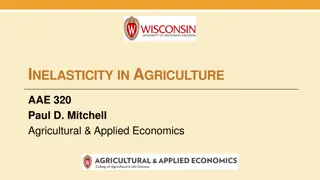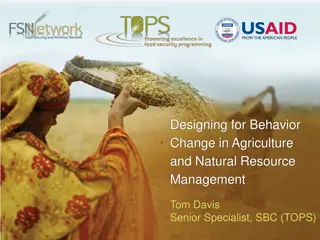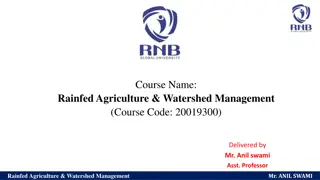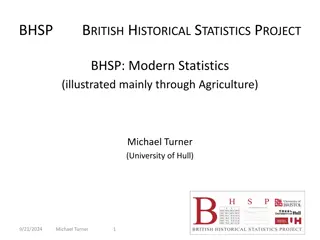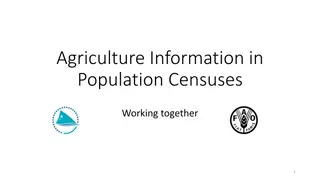Understanding Inelasticity in Agriculture
Learn about the inelastic nature of agricultural supply and food demand compared to other types of supply and demand. Explore the impacts of inelasticity on agricultural prices and farm income, along with the concept of elasticity in economics. Discover why food demand and agricultural product supply are relatively inelastic due to biological, social, and cultural factors.
Download Presentation

Please find below an Image/Link to download the presentation.
The content on the website is provided AS IS for your information and personal use only. It may not be sold, licensed, or shared on other websites without obtaining consent from the author. Download presentation by click this link. If you encounter any issues during the download, it is possible that the publisher has removed the file from their server.
E N D
Presentation Transcript
INELASTICITY IN AGRICULTURE AAE 320 Paul D. Mitchell
Learning Goal Become aware that ag supply and food demand are relatively inelastic compared to many other types of supply and demand Understand the impacts of this inelasticity on ag prices and farm income Means large price swings for small supply/demand changes and small supply/demand changes for large price swings Means large swings in farm income and consumer spending on food
Elasticity Economists use the term elasticity to talk about the responsiveness between factors that are connected How responsive one factor is to changes in another factor Own price elasticity, income elasticity, cross price elasticity Own Price Elasticity: how price responds to changes in quantity (either quantity of supply or demand) Own Price Elasticity = percentage change in price over percentage change in quantity: how much price changes if have a sudden supply or demand shock Own Price Elasticity = % P / % Q Like a slope, but normalized by using percentage changes so does not depend on units of measure used
Why is food demand relatively inelastic? Biological: Not really any substitutes for food, and can only eat so many calories We always need to eat, but can only eat so much Social/Cultural: Many foods and diets are culturally set, slow to change, even with large price swings Why is agricultural product supply relatively inelastic? Biological: Long crop and livestock life cycles: can t change supply quickly Social/Cultural: Few uses for land other than agriculture and farmers tied emotionally to agriculture
Inelastic Supply and Demand Elastic Supply and Demand Price Price Quantity Quantity Both curves are steep in quantity, flat in price Both curves are flat in quantity steep in price Agricultural supply and food demand curves are relatively inelastic in quantity, So What!
Inelastic Supply and Demand Elastic Supply and Demand Price Price Quantity Quantity Same-sized supply shift Small Price Change Price Price Large Price Change Quantity Quantity
Inelastic Supply and Demand Elastic Supply and Demand Price Price Quantity Quantity Same-sized demand shift Small Price Change Price Price Large Price Change Quantity Quantity
Implications of Inelastic Supply and Demand for Food/Ag Products Large price changes for small quantity changes Small quantity changes for large price changes Tariffs cause milk prices to drop, but farmers still milk cows every day and don t start selling cows Quinoa prices skyrocket as farmers race to keep up with demand, then drop fast once market supplied Same thing for sweet cherries, peaches, new potatoes, when they first come in People keep buying milk in store even if prices go up If beef prices plummet, people don t start eating beef for breakfast, lunch and dinner Ag/food supplies and demands often vary due to weather, disruptions, food fads/scares so prices vary greatly
CBOT Weekly Average Price for December 2018 Corn 4.20 18.5% decrease from $4.05 to $3.40 (May 20 to July 8) 4.10 4.00 3.90 3.80 3.70 3.60 3.50 3.40 3.30 3.20 22-Sep-17 11-Nov-17 31-Dec-17 19-Feb-18 10-Apr-18 30-May-18 19-Jul-18 7-Sep-18 https://www.investing.com/commodities/us-corn-historical-data
Income effects of highly variable prices: Farmers bear the costs of price variability because they are inelastic. They do not or cannot respond to crop and livestock price changes, so they lose money when prices are low and make money when prices are high
Summary Agricultural supply and food demand are relatively inelastic non-responsive to price changes Biological and cultural reasons for these Large price swings for small supply/demand changes Small supply/demand changes for large price swings Large swings in farm income and consumer spending on food as weather and other factors shock the system The effects of this inelasticity on farm income and consumer spending are important factors driving ag and food policy in many nations









